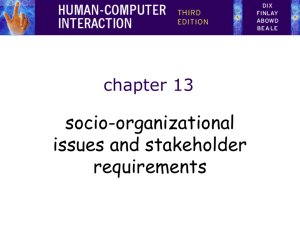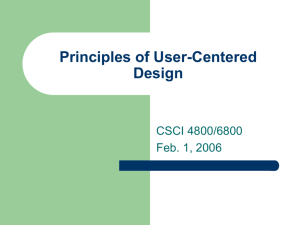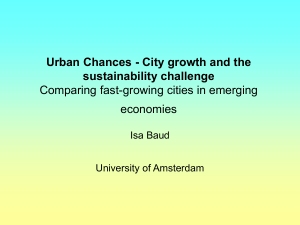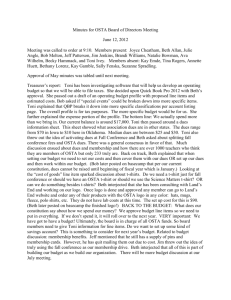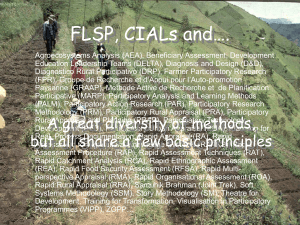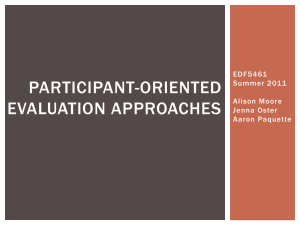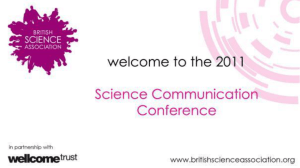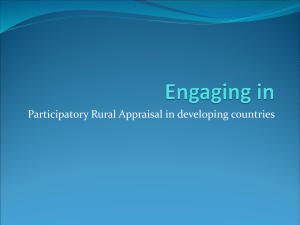socio-organizational issues and stakeholder requirements
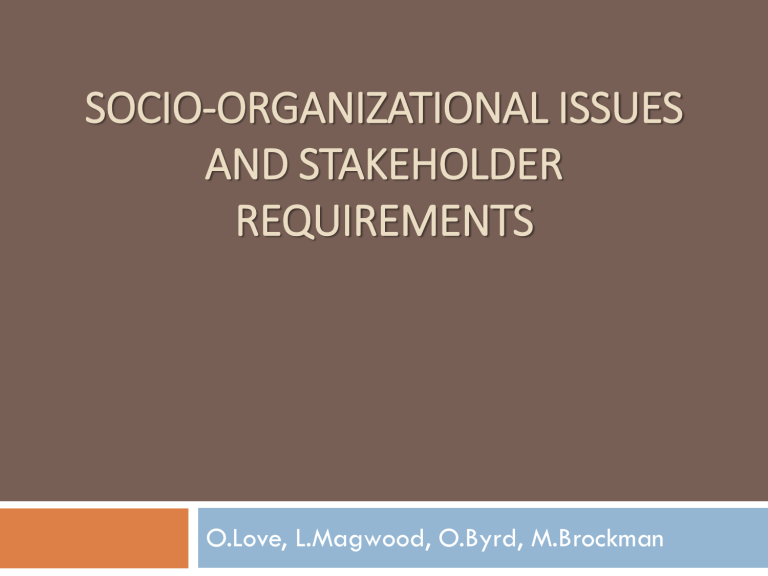
SOCIO-ORGANIZATIONAL ISSUES
AND STAKEHOLDER
REQUIREMENTS
O.Love, L.Magwood, O.Byrd, M.Brockman
Organizational Issues
They affect the acceptance and relevance of new information and communication systems.
Why Stakeholders Must be Identified
Stakeholders must be identified so that information can transfer and to power relationships that cut across organizational structure.
Stakeholders also need to know the severity of the situations and how it affects them and their subordinates whether it be positive or negative.
Who are the STAKEHOLDERS?
A stake holder is anyone who is effected by the success and failure of the system
Four types of stake holders:
-primary: actual users of the system
-secondary: receive output and provide input
-tertiary: no direct involvement but effected by the success and failure
-facilitating: involved in development of the system
Helping you understand
Stakeholders
http://www.youtube.com/watch?v=uKozswXz7q
M
So how socio-technology effect business
Understanding that socio-technical models affect and are composed of both human and machine elements.
The focus of this approach is to describe and document the impact of the introduction of a specific technology into a organization.
Socio-technology cont…
Methods vary but most attempt to capture certain common elements
The problem being addressed
The stakeholders affected
Formal and informal work groups
Changes
Proposed technology
External constraints.
CUSTOM Methodology
A Socio-technical methodology designed to be practical to use in small organizations.
Based on User Skills and Task Match (USTM)
Developed to allow design teams to understand fully document user requirements
Establishes stakeholder requirements
All stakeholders are considered, not jus the end-user
CUSTOM Methodology Cont…
Applied at the initial state of design
Product Opportunity – Emphasis is on capturing requirements.
Forms- Based methodology
Providing a set of questions to apply at each of its stages
6 Key Stages
6 key stages to carry out in a CUSTOM analysis:
1.
Describe context
2.
3.
Identify stakeholders
Identify work-groups
4.
5.
6.
Identify task
Identify needs
Consolidate
OSTA
OSTA stands for Open System Task Analysis
The OSTA has Eight stage model that focus on certain task.
OSTA Stage Model
The primary task identified in terms of users’ goals
task inputs to system identified
external environment into which the system will be introduced is described, including physical, economic and political aspects
transformation processes within the system are described in terms of actions performed on or with objects
OSTA Stage Model Part 2
social system is analyzed, considering existing internal and external work-groups and relationships technical system is described in terms of configuration and integration with other systems performance satisfaction criteria are established, indicating social and technical requirements of system new technical system is specified
Soft Systems Methodology
Was developed by Checkland
There are no assumption of technological solutions but there is an emphasis on understanding situation fully.
There are stages to Soft System Methodology
Soft Systems Methodology Stages
recognition of problem and initiation of analysis
detailed description of problem situation
rich picture
generate root definitions of system
CATWOE
conceptual model - identifying transformations
compare real world to conceptual model
identify necessary changes
determine actions to effect changes
Root definitions of system (CATWOE)
Clients: those who receive output or benefit from the system
Actors: those who perform activities within the system
Transformations: the changes that are affected by the system
Weltanschauung: (from the German) or World View - how the system is perceived in a particular root definition
Owner: those to whom the system belongs, to whom it is answerable and who can authorize changes to it
Environment: the world in which the system operates and by which it is influenced
Once Identified…
We then identify the transformations and how it is achieved using the conceptual model. Next we return to our real world system. Finally we decide if the changed are necessary and beneficial to the system as a whole.
Participatory Design
Participatory design is a philosophy that encompasses the whole design cycle
Design in the workplace, design team
Users actively collaborate
Actively participate
Main Characteristics
Improve the work environment
Collaboration
Interactive approach
Participatory Design Cont…
Methods to help convey information between the user and designer
Brainstorming-
All participants are involved
Informal
Unstructured
“On-the-fly” ideas
Recorded
No judgment
Participatory Design Cont…
Storyboarding- can be used as a means of describing the user’s day-to-day activities as well as the potential designs and the impact they will have.
Participatory design continued…
Workshops- fill missing knowledge, getting ideas from both users and designers. Allowing everyone to get a more focused view on the design.
Pencil and paper exercises- gives everyone a change to walk-through the system using mock designs
Just a little example
http://www.youtube.com/watch?v=o-_8d2l_sBE
Ethnography
Is based on very detailed recording of the interactions between people and between people and their environment.
Special focus on social relationships
Ethnographic tradition
Ethnography is based on very detailed recording of the interactions between people and their environments. It has a special focus on social relationships and how they affect the nature of work. The ethnographer does not enter actively into the situation, and does not see things from a particular person’s point of view
